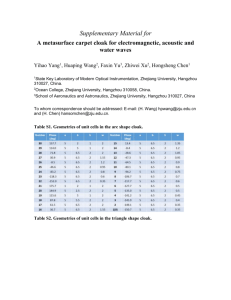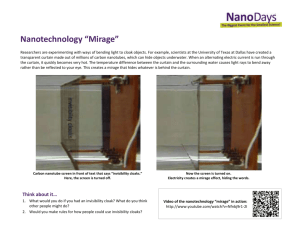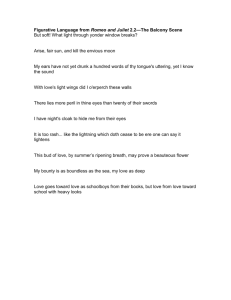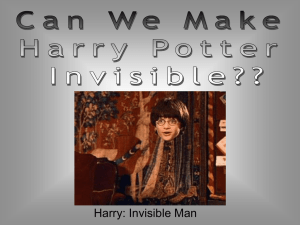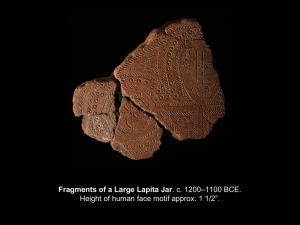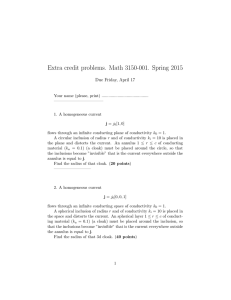One-Directional Perfect Cloak Created With Homogeneous Material Please share
advertisement
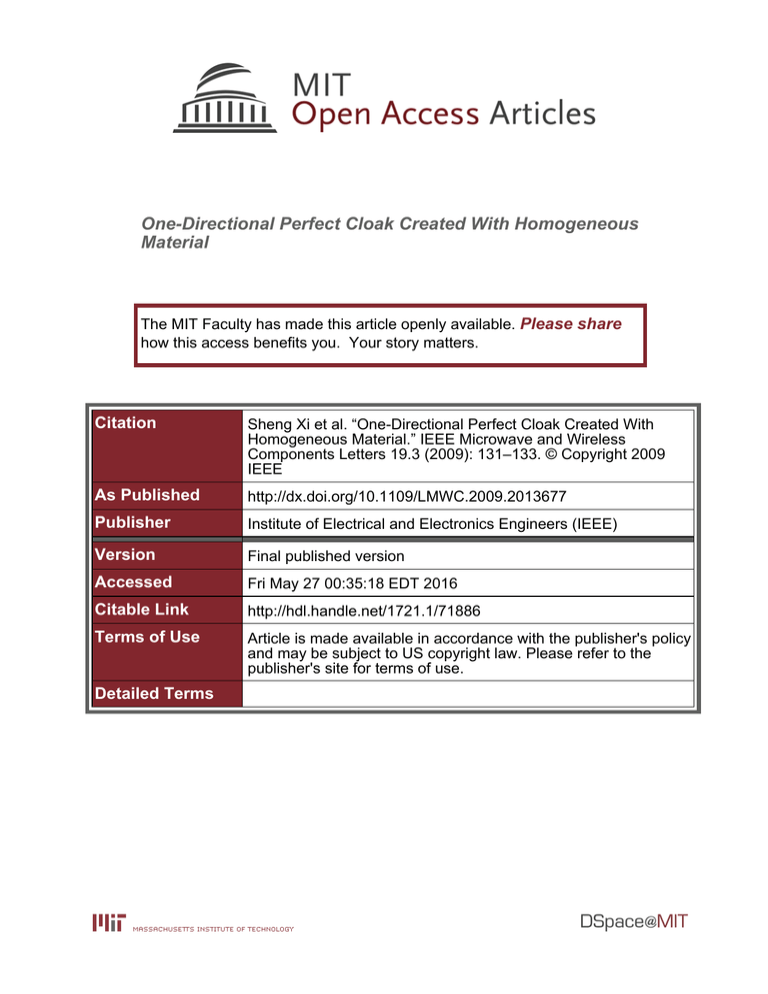
One-Directional Perfect Cloak Created With Homogeneous Material The MIT Faculty has made this article openly available. Please share how this access benefits you. Your story matters. Citation Sheng Xi et al. “One-Directional Perfect Cloak Created With Homogeneous Material.” IEEE Microwave and Wireless Components Letters 19.3 (2009): 131–133. © Copyright 2009 IEEE As Published http://dx.doi.org/10.1109/LMWC.2009.2013677 Publisher Institute of Electrical and Electronics Engineers (IEEE) Version Final published version Accessed Fri May 27 00:35:18 EDT 2016 Citable Link http://hdl.handle.net/1721.1/71886 Terms of Use Article is made available in accordance with the publisher's policy and may be subject to US copyright law. Please refer to the publisher's site for terms of use. Detailed Terms IEEE MICROWAVE AND WIRELESS COMPONENTS LETTERS, VOL. 19, NO. 3, MARCH 2009 131 One-Directional Perfect Cloak Created With Homogeneous Material Sheng Xi, Hongsheng Chen, Bae-Ian Wu, and Jin Au Kong, Fellow, IEEE Abstract—A one-directional invisibility cloak is presented in this letter. Perfect invisibility can be achieved for TM waves along certain directions. The parameters are just homogeneously anisotropic and relatively easy for practical realizations. Nonmagnetic cloak is also studied to further reducing the complexity of the cloak parameters. Thin layered systems with alternating isotropic materials are then designed to model the parameters of such kind of cloaks. Index Terms—Cloak, coordinate transformation, metamaterial. Fig. 1. Scheme of coordinate transformation for the one-directional cloak. (a) The original space where a PEC surface with infinitesimal thickness lies between a and a. (b) The transformed space with diamond PEC inner boundary. The position vector r turns to be r after the transformation. I. INTRODUCTION 0 P RECURSORY efforts [1]–[4] have been made on the invisibility devices, among which, Pendry et al. theoretically proposed full wave perfect invisibility cloaking based on the coordinate transformation method [1]. Later, finite element method based simulations [5], [6] were carried out to verify the behaviors of cylindrical cloaks. And the cylindrical cloak with simplified parameters was then experimentally fabricated and validated [7]. Theoretical methods such as ray tracing [8] and full wave scattering theory [9], [10] have also been utilized to demonstrate the effectiveness of the spherical and cylindrical cloaks. In virtue of the flexibility of the coordinate transformation method [1], arbitrary transformation functions and shapes can be utilized to design invisibility cloaks [11]–[15]. The requirement of continuously inhomogeneous and highly anisotropic material for point and line transformed perfect cloaks [14] is a serious restriction for the practical fabrications. Simplified models with less constraints on the parameters were then proposed to reduce the complexity of realizations [5], [7]. However, the inherent scatterings [16] caused by the simplification are unavoidable. Meanwhile, the simplified parameters are still continuously inhomogeneous, thus it is also inconvenient for fabrications. In [17] and [18], the scattering of cylindrical objects is reduced using hard surfaces, however, the objects are still visible. In this letter, we present a one-directional perfect cloak composed of only homogeneously anisotropic materials. The idea Manuscript received July 12, 2008; revised November 28, 2008. Current version published March 11, 2009. This work was supported by the Chinese NSF under Grants 60801005 and 60531020, the ZJNSF (R1080320), the Doctoral Fund of MEC under Grant 200803351025, the ONR under Grant N00014-06-10001, and the Department of the Air Force under Grant F19628-00-C-0002. The authors are with the Electromagnetics Academy, Zhejiang University, Zhejiang University, Hangzhou 310058, China and also with the Research Laboratory of Electronics, Massachusetts Institute of Technology, Cambridge, MA 02139 USA (e-mail: chenhs@ewt.mit.edu). Color versions of one or more of the figures in this letter are available online at http://ieeexplore.ieee.org. Digital Object Identifier 10.1109/LMWC.2009.2013677 is raised based on the fact that there will be no scattering when TM polarized waves incident onto an infinitesimal PEC surface, with the electric fields perpendicular to the surface. Therefore, by transforming a diamond space containing the infinitesimal PEC surface to the space with a diamond PEC inner boundary (see Fig. 1), the topology [8], [19] of the space stays unchanged and a perfect cloak for TM waves is obtained. The advantage of this kind of cloak is that the parameters are only homogeneously anisotropic, which will facilitate practical realizations. One directional nonmagnetic cloaks are also proposed based on the the simplified parameters. Finite element based simulations are carried out, showing the effectiveness of the proposed cloak. II. TRANSFORMATION SCHEME Consider the two-dimensional case of a transformation beand the transformed space tween the original space shown by Figs. 1(a) and (b) respectively. The diamond space in the original space demonstrated by the angle is compressed into the space . Taking the space in the first quadrant as an example, the transformation equations are (1) where and . Following the procedures in [8], the parameters are then obtained as (2) By combining four pieces of such material together, a diamond hole determined by the angle is created as shown in Fig. 1(b). In order to keep the topology of the space during the transformation, the boundary of the hole is set to be PEC. Then one 1531-1309/$25.00 © 2009 IEEE 132 IEEE MICROWAVE AND WIRELESS COMPONENTS LETTERS, VOL. 19, NO. 3, MARCH 2009 Fig. 3. Layered system for modeling the one-directional cloak. Fig. 2. Magnetic field distribution and the Poynting vectors when a ized plane wave incident on to the perfect cloak. H polar- can imagine that, when an polarized wave incident onto the cloak, perfect invisibility can be achieved. It’s ineresting to see that the constitutive parameters shown by (2) are spacially invariant, which can be expressed as diagonal constant tensors in their local principal coordinate system obtained from the the original coordinate rotated by the angle shown in Fig. 1(b), with (3) III. FULL PARAMETER CLOAKS For example, we create a cloak with and , where is the wavelength of the incident wave. Then the parameters in the first quadrant are and in their local coordinate system, with . For a TM plane wave with unit magnitude incident along direction, the magnetic field distribution and the Poynting vectors can then be obtained from the numerical simulation as shown in Fig. 2. We can see that the fields outside the cloak stay unperturbed, that is to say, a perfect cloak can be achieved. Actually, there exists some minor scatterings in the simulation because of the numerical errors, which almost cannot be observed in Fig. 2. When passing through the cloak, the power is compressed and then undergoes negative refractions on the in. On the PEC inner boundary, surface currents terface at are exited to match the boundary condition and no scattering is aroused. And the small perturbations of the material used near will have little effect on the performance of the cloak. As shown by [22]–[24], a thin layered system with homogeneous and isotropic permittivity and permeability parameters can be treated as a single anisotropic medium. Making use of this concept, as shown by Fig. 3, thin layered system is utilized to model our proposed cloak. Here, the thickness of the layers are kept identical. For the above perfect cloak, the permittivity and parameters for the two types of materials are respectively, where can be realized by electric plasmas, and the permeability are for both of them. Fig. 4. Far field scattering efficiency for bare PEC square (solid line), full parameters cloak with 9 layers (dashed line) and 18 layers (dotted line). Then the thin layered system is established for the numerical simulations, in which the field distributions can be obtained. Then the far field scattering pattern can be obtained from the near field using the Stratton-Chu formulas [25], as shown by Fig. 4. The solid line shows the normalized far field scattering efficiency of the bare PEC square, which indicates large scat(forward) and directions. When the PEC tering in the square is coated by a cloak with 18 layers (9 periods) of the proposed structure, the scattering is reduced for almost all the directions as shown by the dotted line. As a result of the homogenization of the layered system, near-zero scattering can be achieved as long as there are enough layers in a single wavelength. IV. NONMAGNETIC CLOAKS Since it is much easier to create cloaks with only dielectric materials in practice, a one directional nonmagnetic cloak [12] and with the simplified parameters is then obtained from the above perfect cloak. The dash dotted line in Fig. 5 shows that a reduction of about 22 dB for the forward and 28 dB for the backward scattering has been achieved by using such a nonmagnetic cloak. This kind of nonmagnetic cloak can also be achieved by the layered system with and respectively. As the scattering properties shown by the dashed line and dotted line in Fig. 5, a reduction in the scattering can also be observed when the number of layers increases. XI et al.: ONE-DIRECTIONAL PERFECT CLOAK 133 cloaks. Our results show the possibility to realize perfect invisibility in practice. REFERENCES Fig. 5. Far field scattering efficiency for bare PEC square (solid line), nonmagnetic cloak with 9 layers (dashed line), with 18 layers (dotted line), and with homogeneously anisotropic parameters (dash dotted). Fig. 6. Scheme of a one directional cloak for a finite volume, which has perfect performance for E polarized waves, where the gray surfaces represents the PEC inner boundaries. V. CONCLUSION It should be noted, which hasn’t been pointed out, that the surface transformed cloak presented by [15] and [24] can form perfect cloaks with PMC inner boundary for TE waves, but the parameters are position dependent. However, for all of them, the inner object is masked to be a infinitesimal surface [20], [21]. Our concept of surface transformed cloak can also be expanded to conceal a finite volume by transforming a surface of finite area. For example, in Fig. 1(a), assuming the PEC surface has the same length in direction as in direction and taking a polarized similar transformation as (1), a perfect cloak for waves can be achieved as shown in Fig. 6 with the same material properties as the two dimensional one. For the waves with other polarizations, by combining polarization transformers and our proposed cloak, one directional perfect invisibility can also be achieved. In conclusion, one directional perfect cloaks composed of homogeneously anisotropic materials are proposed. By transforming an infinitesimal PEC surface to a volume in the transformed space, a cloak is formed with perfect performance for certain polarized waves. Meanwhile, the parameters are quite simple. One directional nonmagnetic cloaks are also proposed. Thin layered systems are then utilized to model such kind of [1] J. B. Pendry, D. Schurig, and D. R. Smith, “Controlling electromagnetic fields,” Science, vol. 312, pp. 1780–1782, 2006. [2] A. Greenleaf, M. Lassas, and G. Uhlmann, “Anisotropic conductivities that cannot be detected by EIT,” Physiol. Meas., vol. 24, pp. 413–419, 2003. [3] A. Alù and N. Engheta, “Achieving transparency with plasmonic and metamaterial coatings,” Phys. Rev. E, vol. 72, p. 016623, 2005. [4] U. Leonhardt, “Optical conformal mapping,” Science, vol. 312, pp. 1777–1780, 2006. [5] S. A. Cummer, B.-I. Popa, D. Schurig, D. R. Smith, and J. B. Pendry, “Full-wave simulations of electromagnetic cloaking structures,” Phys. Rev. E, vol. 74, p. 036621, 2006. [6] F. Zolla, S. Guenneau, A. Nicolet, and J. B. Pendry, “Electromagnetic analysis of cylindrical invisibility cloaks and the mirage effect,” Opt. Lett., vol. 32, pp. 1069–1071, 2007. [7] D. Schurig, J. J. Mock, B. J. Justice, S. A. Cummer, J. B. Pendry, A. F. Starr, and D. R. Smith, “Metamaterial electromagnetic cloak at microwave frequencies,” Science, vol. 314, pp. 977–980, 2006. [8] D. Schurig, J. B. Pendry, and D. R. Smith, “Calculation of material properties and ray tracing in transformation media,” Opt. Express, vol. 14, pp. 9794–9804, 2006. [9] H. Chen, B. I. Wu, B. Zhang, and J. A. Kong, “Electromagnetic wave interactions with a metamaterial cloak,” Phys. Rev. Lett., vol. 99, p. 063903, 2007. [10] B. Zhang, H. Chen, B. I. Wu, Y. Luo, L. Ran, and J. A. Kong, “Response of a cylindrical invisibility cloak to electromagnetic waves,” Phys. Rev. B, vol. 76, p. 121101(R), 2007. [11] M. Rahm, D. Schurig, D. A. Roberts, S. A. Cummer, D. R. Smith, and J. B. Pendry, “Design of electromagnetic cloaks and concentrators using form-invariant coordinate transformations of Maxwell’s equations,” Photon. Nanostruct.: Fundam. Appl., vol. 6, p. 87, 2008. [12] W. S. Cai, U. K. Chettiar, A. V. Kildishev, V. M. Shalaev, and G. W. Milton, “Nonmagnetic cloak with minimized scattering,” Appl. Phys. Lett., vol. 91, p. 111105, 2007. [13] R. Weder, “A rigorous analysis of high-order electromagnetic invisibility cloaks,” J. Phys. A: Math. Theor., vol. 41, p. 065207, 2008. [14] W. Yan, M. Yan, Z. Ruan, and M. Qiu, “Coordinate transformations make perfect invisibility cloaks with arbitrary shape,” New J. Phys., vol. 10, p. 043040, 2008. [15] H. Ma, S. Qu, Z. Xu, J. Zhang, B. Cheng, and J. Wang, “Material parameter equation for elliptical cylindrical cloaks,” Phys. Rev. A, vol. 77, p. 013825, 2008. [16] M. Yan, Z. Ruan, and M. Qiu, “Cylindrical invisibility cloak with simplified material parameters is inherently visible,” Phys. Rev. Lett., vol. 74, p. 115116, 2006. [17] P.-S. Kildal, “Artificially soft and hard surfaces in electromagnetics,” IEEE Trans. Antennas Propagat., vol. 38, no. 10, pp. 1537–1544, Oct. 1990. [18] P.-S. Kildal, A. A. Kishk, and A. Tengs, “Reduction of forward scattering from cylindrical objects using hard surfaces,” IEEE Trans. Antennas Propagat., vol. 44, no. 11, pp. 1509–1520, Nov. 1996. [19] B. Donderici and F. L. Teixeira, “Metamaterial blueprints for reflectionless waveguide bends,” IEEE Microw. Wireless Compon. Lett., vol. 18, no. 4, pp. 233–235, Apr. 2008. [20] O. Ozgun and M. Kuzuoglu, “Electromagnetic methamorphosis: Reshaping scatterers via conformal anisotopic metamaterial coatings,” Microw. Opt. Technol. Lett., vol. 49, no. 10, pp. 2386–2392, 2007. [21] F. L. Teixeira, “Closed-form metamaterial blueprints for electromagnetic masking of arbitrarily shaped convex PEC objects,” IEEE Antennas Wireless Propag. Lett., vol. 6, pp. 163–164, 2007. [22] B. Wood, J. B. Pendry, and D. P. Tsai, “Directed subwavelength imaging using a layered metal-dielectric system,” Phys. Rev. B, vol. 77, p. 013825, 2008. [23] Y. Huang, Y. Feng, and T. Jiang, “Electromagnetic cloaking by layered structure of homogeneous isotropic materials,” Opt. Express, vol. 15, p. 11133, 2007. [24] H. Chen and C. T. Chan, “Electromagnetic wave manipulation by layered systems using the transformation media concept,” Phys. Rev. B, vol. 78, p. 054204, 2008. [25] J. A. Kong, Electromagnetic Wave Theory. Cambridge, MA: EMW Publishing, 2005.
